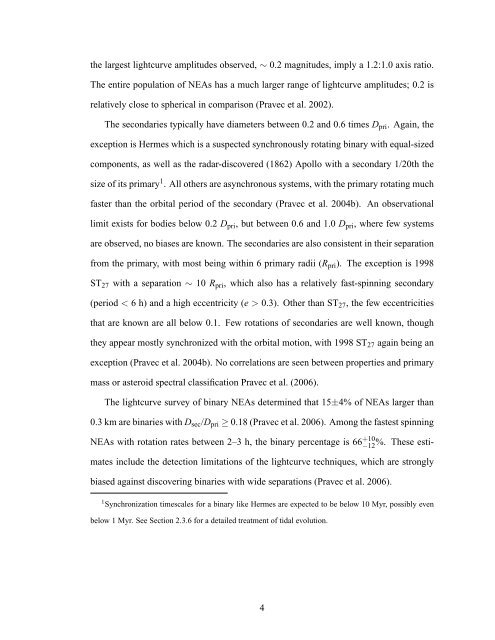Forming Binary Near-Earth Asteroids From Tidal Disruptions
Forming Binary Near-Earth Asteroids From Tidal Disruptions
Forming Binary Near-Earth Asteroids From Tidal Disruptions
You also want an ePaper? Increase the reach of your titles
YUMPU automatically turns print PDFs into web optimized ePapers that Google loves.
the largest lightcurve amplitudes observed, ∼ 0.2 magnitudes, imply a 1.2:1.0 axis ratio.The entire population of NEAs has a much larger range of lightcurve amplitudes; 0.2 isrelatively close to spherical in comparison (Pravec et al. 2002).The secondaries typically have diameters between 0.2 and 0.6 times D pri . Again, theexception is Hermes which is a suspected synchronously rotating binary with equal-sizedcomponents, as well as the radar-discovered (1862) Apollo with a secondary 1/20th thesize of its primary 1 . All others are asynchronous systems, with the primary rotating muchfaster than the orbital period of the secondary (Pravec et al. 2004b). An observationallimit exists for bodies below 0.2 D pri , but between 0.6 and 1.0 D pri , where few systemsare observed, no biases are known. The secondaries are also consistent in their separationfrom the primary, with most being within 6 primary radii (R pri ). The exception is 1998ST 27 with a separation ∼ 10 R pri , which also has a relatively fast-spinning secondary(period < 6 h) and a high eccentricity (e > 0.3). Other than ST 27 , the few eccentricitiesthat are known are all below 0.1. Few rotations of secondaries are well known, thoughthey appear mostly synchronized with the orbital motion, with 1998 ST 27 again being anexception (Pravec et al. 2004b). No correlations are seen between properties and primarymass or asteroid spectral classification Pravec et al. (2006).The lightcurve survey of binary NEAs determined that 15±4% of NEAs larger than0.3 km are binaries with D sec /D pri ≥ 0.18 (Pravec et al. 2006). Among the fastest spinningNEAs with rotation rates between 2–3 h, the binary percentage is 66 +10−12%. These estimatesinclude the detection limitations of the lightcurve techniques, which are stronglybiased against discovering binaries with wide separations (Pravec et al. 2006).1 Synchronization timescales for a binary like Hermes are expected to be below 10 Myr, possibly evenbelow 1 Myr. See Section 2.3.6 for a detailed treatment of tidal evolution.4












